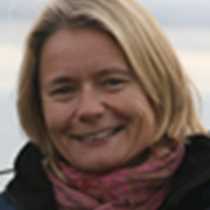Mahon & Ciudadela, Spain
Sailing in through the natural harbor of Mahon, Spain was bliss. The ocean swells brought us here mid morning. Most guests took off for a great day exploring Mahon on the island of Menorca. After lunch an exploration of the island took us to the coastal town of Ciudadela. We exited the beautiful natural harbor by Zodiac and returned to the ship for a presentation by Tim Severin on "Ulysses & The Odyssey". Those of us who spent the late evening on deck experienced a most amazing light show in the sky.
On a day like today it is my great pleasure to bring the underwater world of the Mediterranean Sea on board for everyone to enjoy, using state of the art technology for presentations to inspire you all to care and explore the planet as a whole. It is so easy to forget about the life beneath the sea we travel upon; the inhabitants' constant struggle to survive in this vast inland sea threatened by heavy pollution, fisheries and ship trafficking. The jewels that remain beneath us are delicate plants and animals that need protection as we do. The sea-grass beds and the wild topography that mirrors the landscape above still sustain small pockets of a very important ecosystem.
In the picture above this colorful wall is covered in brightly colored hard cup corals (tubastrea), an immensely pleasing sight in the otherwise green, grey world of algae that for the most part cover the sea-floor of the Mediterranean. The colony of hard corals pictured is a species that will take advantage of feeding when the current is running; in the picture most polyps are retracted. When the tentacles of the polyps are extended they catch the food by stinging the organic material floating by before devouring it in their stomachs.
Corals belong in the class Anthozoa. To simplify the world of corals; there are soft corals and hard corals. A large group of the hard corals are reef-building corals. There are no reef building corals in the Mediterranean, not because of pollution but due to the water properties in these latitudes. There are smaller colonies of hard coral like the reef building corals that secret a skeleton of calcium carbonate providing protection for the animal itself. When the coral polyp dies (the orange fleshy bit in the picture) the only thing left is the limestone skeleton. A species of hard coral we have all seen as 'shoppers' on our voyage is the endangered Red Coral 'Corallium Rubrum'.
Sailing in through the natural harbor of Mahon, Spain was bliss. The ocean swells brought us here mid morning. Most guests took off for a great day exploring Mahon on the island of Menorca. After lunch an exploration of the island took us to the coastal town of Ciudadela. We exited the beautiful natural harbor by Zodiac and returned to the ship for a presentation by Tim Severin on "Ulysses & The Odyssey". Those of us who spent the late evening on deck experienced a most amazing light show in the sky.
On a day like today it is my great pleasure to bring the underwater world of the Mediterranean Sea on board for everyone to enjoy, using state of the art technology for presentations to inspire you all to care and explore the planet as a whole. It is so easy to forget about the life beneath the sea we travel upon; the inhabitants' constant struggle to survive in this vast inland sea threatened by heavy pollution, fisheries and ship trafficking. The jewels that remain beneath us are delicate plants and animals that need protection as we do. The sea-grass beds and the wild topography that mirrors the landscape above still sustain small pockets of a very important ecosystem.
In the picture above this colorful wall is covered in brightly colored hard cup corals (tubastrea), an immensely pleasing sight in the otherwise green, grey world of algae that for the most part cover the sea-floor of the Mediterranean. The colony of hard corals pictured is a species that will take advantage of feeding when the current is running; in the picture most polyps are retracted. When the tentacles of the polyps are extended they catch the food by stinging the organic material floating by before devouring it in their stomachs.
Corals belong in the class Anthozoa. To simplify the world of corals; there are soft corals and hard corals. A large group of the hard corals are reef-building corals. There are no reef building corals in the Mediterranean, not because of pollution but due to the water properties in these latitudes. There are smaller colonies of hard coral like the reef building corals that secret a skeleton of calcium carbonate providing protection for the animal itself. When the coral polyp dies (the orange fleshy bit in the picture) the only thing left is the limestone skeleton. A species of hard coral we have all seen as 'shoppers' on our voyage is the endangered Red Coral 'Corallium Rubrum'.




